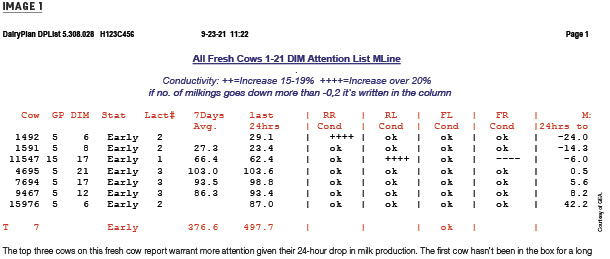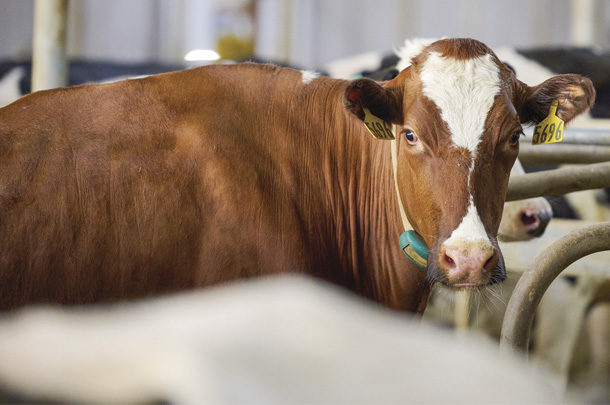Smooth, comfortable, stress-free. That’s what riding in a new vehicle feels like. And that’s exactly how your fresh heifers and cows want to transition into their lactation – with a smooth ride.
Early robot acclimation and using data to keep a close eye on fresh cows will help avoid bumps in the road or unexpected curves. Set your fresh cows up for a strong robotic milking performance with these management tips.
Start early
Creating a smooth transition period begins at dry-off or 60 days pre-calving. Cows undergo many changes during this time with feed adjustments, dry-off and a housing move. And heifers are about to experience many firsts with calving and entering the milking herd – along with getting accustomed to a robot.
At dry-off, it’s important to treat existing mastitis cases and manage the dry cow housing area to reduce the chance of new cases at calving. And work with your nutritionist to develop a transition cow feed plan to minimize post-calving illness.
Another way to avoid bumps in the road during transition is using an animal health monitoring system to track activity, eating and rumination time before calving. By monitoring the full group, dry cows and close-up heifers, you can compare individual data to group data. If one animal’s eating time is lower than the rest of the group, she might have an early transition issue and need attention. Monitoring systems can also help you see trends indicating an animal is near calving, which can be a helpful time-saver on-farm.
Test drive
With fresh heifers, starting training visits a couple of weeks before calving familiarizes them with the robot. Training visits will help heifers get comfortable with what they’ll experience inside the robot – the way the gate opens and closes, how the feed dispenses and the noises it makes. You can also set the feed amount and intervals: For example, the heifer could enter the robot every eight hours and get a small portion of feed. Once she calves in, she’s familiar with the robot and only needs to adapt to the milking process.
On a robotic rotary, giving a heifer a ride around on it once or twice before milking will familiarize her with the system, make her calmer and improve her first milking experience. If time isn’t available to do this before calving, try to position her between calm, older fresh cows for the first milking.
Prioritize fresh fetch animals
Always prioritize fresh heifers and cows when reviewing your fetch list to ensure they’re transitioning well and help you stay in front of health issues. It’s important to check they’re getting through the boxes enough. Set up your reports so they appear at the top of your list.
If you see fresh animals aren’t going through the box enough, find them and physically look at them to discover why. For example, if a heifer appears on the fetch list who’s 10 days in milk (DIM) and usually isn’t a fetch cow – find her to see what’s going on. Review activity, eating, rumination and production data before you perform a cow-side evaluation. The data might point you to a specific issue. For example, if her conductivity is high and milk production low, mastitis is likely an issue.
Check the following during your evaluation:
- Temperature
- Rumen fill
- Signs of mastitis, metritis, ketosis, injury or lameness
- Is she alert and responsive? Does she have a cough?
If your barn layout allows, keep all fresh cows in one pen to make it easier to find and check them. If you have a lot of fresh animals, consider adding a mid-day fetch for fresh cows only.
Monitor the data
Monitoring the data is just as important as visually analyzing fresh cows. Sometimes you can look at a cow or heifer and she looks good – but the data tells another story. For example, she looks bright-eyed and alert, but the data shows she’s down in milk. Or maybe her box visits are low – she might not be adapting well to the robot and needs more visits to become comfortable.
Key reports to review include:
- Robot fresh cow attentions: Shows production and conductivity data for animals at 1 to 21 DIM. A drop in production or increase in conductivity helps identify animals needing attention (Image 1).

- Robot fresh cow report: Compiles robot visits and feed consumption to identify animals with a decline in box visits or those that aren’t consuming their allotted feed. These animals could need to visit the box more, or they’re visiting enough but milking out fast. Consider putting her in a group with priority feeding if you have available box time so when she finishes milking, she’ll consume the full ration provided to her in the box, enabling her to reach her production potential (Image 2).

- Fresh cows leaving the herd: Pulls cows leaving the herd at 1 to 60 DIM. Periodically review this data to identify trends and understand why animals leave the herd in early lactation. Ensure the reason for leaving makes sense for your farm and contains the level of detail necessary to make assessments.
Also watch for changes in activity, eating and rumination data to stay ahead of health issues. Some farms pair their cow monitoring system with a sort gate, which automatically separates animals needing attention into a different pen. It helps farms become more efficient with their time and saves labor.
Have treatment protocols in place for when you identify a problem. Look to your veterinarian to develop and adjust protocols as needed. Make sure your team knows your protocols and has access to them so everyone follows the plan.
As you monitor the data, revisit your protocols and adjust as necessary. The data will help reveal trends to pinpoint areas for improvement. Work alongside your milking equipment dealer and their herd management team to navigate the data and customize reports for your dairy. Together, you can ensure heifers and cows have a smooth ride into their lactation.







